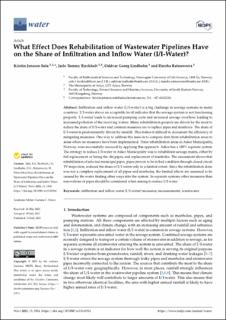| dc.contributor.author | Sola, Kristin Jenssen | |
| dc.contributor.author | Bjerkholt, Jarle Tommy | |
| dc.contributor.author | Lindholm, Oddvar G. | |
| dc.contributor.author | Ratnaweera, Harsha | |
| dc.date.accessioned | 2022-03-28T09:21:00Z | |
| dc.date.available | 2022-03-28T09:21:00Z | |
| dc.date.created | 2021-08-06T16:43:35Z | |
| dc.date.issued | 2021 | |
| dc.identifier.citation | Sola, K. J., Bjerkholt, J. T., Lindholm, O. G. & Ratnaweera, H. (2021). What Effect Does Rehabilitation of Wastewater Pipelines Have on the Share of Infiltration and Inflow Water (I/I-Water)? Water, 13(14), Artikkel 1934. | en_US |
| dc.identifier.issn | 2073-4441 | |
| dc.identifier.uri | https://hdl.handle.net/11250/2987874 | |
| dc.description.abstract | Infiltration and inflow water (I/I-water) is a big challenge in sewage systems in many countries. I/I-water above an acceptable level indicates that the sewage system is not functioning properly. I/I-water leads to increased pumping costs and increased sewage overflow, leading to increased pollution of the receiving waters. Many rehabilitation projects are driven by the need to reduce the share of I/I-water and common measures are to replace pipes and manholes. The share of I/I-water is predominantly driven by rainfall. This makes it difficult to document the efficiency of mitigating measures. One way to address this issue is to compare data from rehabilitation areas to areas where no measures have been implemented. Three rehabilitation areas in Asker Municipality, Norway, were successfully assessed by applying this approach. Asker has a 100% separate system. The strategy to reduce I/I-water in Asker Municipality was to rehabilitate sewage mains, either by full replacement or lining the old pipes, and replacement of manholes. The assessment shows that rehabilitation of selected municipal pipes, pipes proven to be in bad condition through closed circuit TV inspection, reduced the share of I/I-water only to a limited extent. Since the rehabilitation done was not a complete replacement of all pipes and manholes, the limited effects are assumed to be caused by the water finding other ways into the system. In separate systems other measures than renovations of pipes should be considered when aiming to reduce I/I-water. | en_US |
| dc.language.iso | eng | en_US |
| dc.rights | Navngivelse 4.0 Internasjonal | * |
| dc.rights.uri | http://creativecommons.org/licenses/by/4.0/deed.no | * |
| dc.title | What effect does rehabilitation of wastewater pipelines have on the share of infiltration and inflow water (I/I-water)? | en_US |
| dc.type | Peer reviewed | en_US |
| dc.type | Journal article | en_US |
| dc.description.version | publishedVersion | en_US |
| dc.rights.holder | © 2021 by the authors. | en_US |
| dc.source.volume | 13 | en_US |
| dc.source.journal | Water | en_US |
| dc.source.issue | 14 | en_US |
| dc.identifier.doi | https://doi.org/10.3390/w13141934 | |
| dc.identifier.cristin | 1924478 | |
| dc.relation.project | Norges forskningsråd: 272969 | en_US |
| dc.source.articlenumber | 1934 | en_US |
| cristin.ispublished | true | |
| cristin.fulltext | original | |
| cristin.qualitycode | 1 | |

